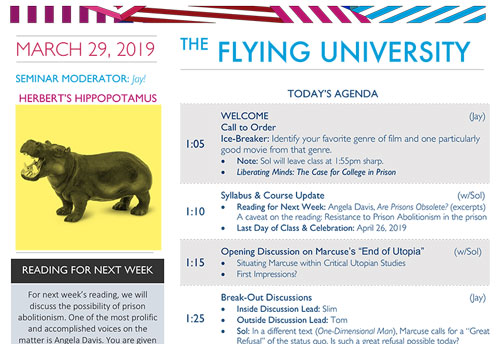Try inclusive class agendas
Last fall, I had the privilege of working with UAS professor Sol Neely in the Flying University, a program that connects UAS and incarcerated students via academic study. There are many things that are special about this program, not the least of which – please believe me – is its practice of using agendas for every class session.

A Flying University agenda is the written-out plan for the day’s class session. It is distributed around the room before class begins: We all know what to expect, we are affirmed in why we are here, and we can, if needed, call for accountability by pointing to this document. This daily agenda creates transparency and inclusion in the Flying University classroom. Of course, it’s possible to use an agenda to an opposite set of ends — after all, “he’s got an agenda” is a way of saying “he’s hiding something” and “he’s not here to be convinced by us.” To get your agenda right — that is, to create transparency and welcome inclusion in the classroom through this tool — consider the following principles. For an online course, consider applying these principles to your “modules” or lessons.
Build in Flexibility
Agendas can be simple lists or can look more like a full-on lesson plan, with activities and time markers. I recommend the latter, so long as you are willing to adjust in real time to what’s needed in the classroom. You might let discussion go an extra 10 minutes and abandon a portion of lecture, for example. These are calculations we usually do in our heads, as we usually come into the classroom with a plan. The difference here is that you are sharing that plan and those calculations, getting consent and input from students throughout. Use the agenda to initiate, not avoid, dialogue and responsiveness in the classroom.
Co-Create, Co-Facilitate
Open class by welcoming a review of the agenda. I have begun using agendas in one of my courses and at the beginning of class I ask everyone to look over the agenda, write in notes/reminders for themselves and raise anything that I’ve missed. We revise the agenda before we begin, as well as throughout the class period.
Flying University classes feature a student facilitator – a student who moves us through the agenda during our three-hour class session. A new student takes on the role each week, puts his spin on facilitation and, more or less, makes decisions about how to adjust and respond to the reality of the class in session. Ideally, this student co-creates the day’s agenda with the class teachers in the week before class, adding his priorities and reflections to the structure.
Ask Questions
Ask for help especially from students who are not finding space or success in your class. If they were designing your time together, what would they spend it on? Be prepared to believe them; understand the agenda process as an opportunity to listen and get feedback.
Don’t leave the logistics/announcements till the end, and hustle through them. This is tempting, as the agenda allows you to write things out instead of dedicating precious class time. Always leave space and time for questioning.
Never Finish
Do not attempt to perfect the agenda. If you get to a place where the agenda has become a template and is largely easy to ignore, it may no longer be serving you. An inclusive agenda is an active agenda, one that changes week by week and even within an agenda-ed session. It may even change in look – more or fewer graphics, excerpts from the reading this week, a quote from student writing (with permission) the next. The agenda is not a solvable problem; rather, it’s a continuous prompt for reflecting on your pedagogy as enacted in the classroom.
Further Reading:
Classroom Transparency by James M Lang
The Power of Transparency in Your Teaching by Amy Mulnix
The Inclusive Learning Design Handbook

Kendell Newman Sadiik
Associate Director of Transformative Teaching
Instructional Designer
LION Liaison



